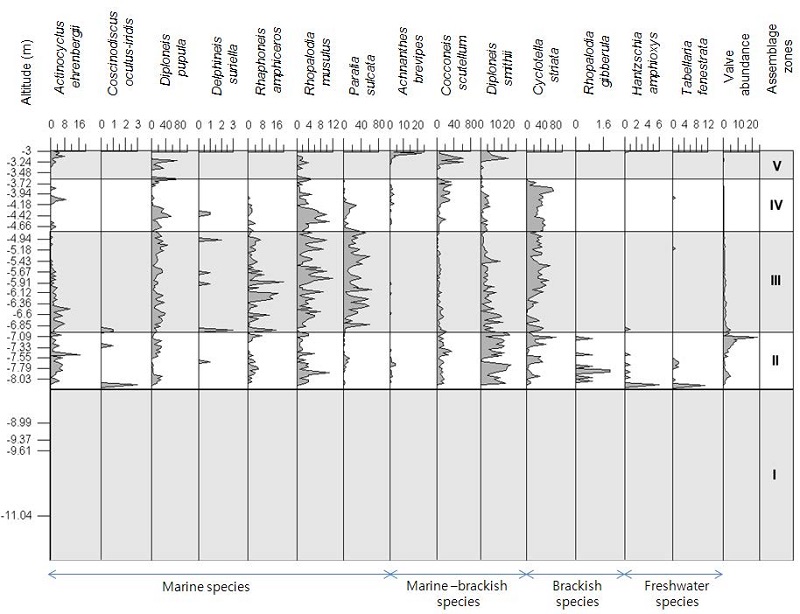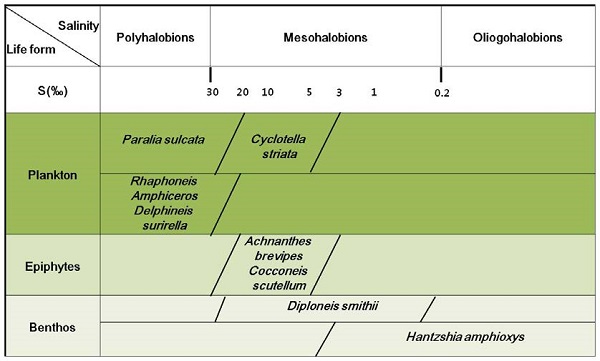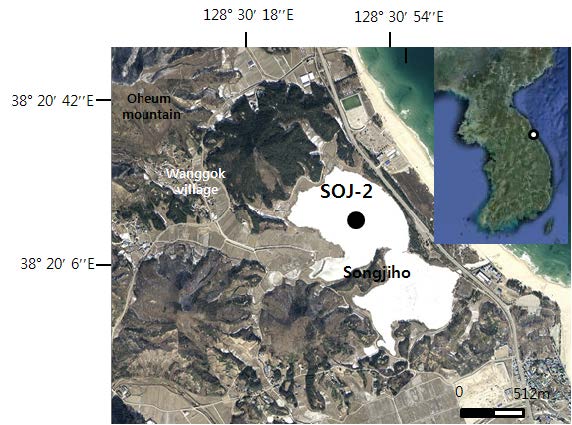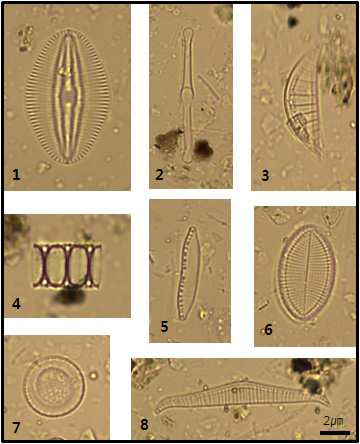
Holocene paleoenvironmental changes from diatom analysis of sediments from the Songjiho Lagoon on the eastern coast of Korea
A total of 50 diatom species belonging to 32 genera were identified from SOJ-2 core sediments in Songjiho Lagoon. Five diatom assemblage zones are identified on the basis of frequency and salinity tolerance of the selected taxa throughout the section. The changes in the depositional environment of the study area are as follows: diatom assemblage zone I (-11.04 ~ -8.15 m); barren zone, diatom assemblage zone II (-8.11 ~ -7.01 m); mesohalobions to oligohalobions (0.2 ~ 5‰), diatom assemblage zone III (-7.01 ~ -4.78 m); polyhalobions to mesohalobions (>20‰), diatom assemblage zone IV (-4.78 ~ -3.64 m); mesohalobions (3 ~ 20‰), diatom assemblage zone V (-3.64 ~ -3 m); terrestrial environment to mesohalobions (3 ~ 5‰).
초록
강원도 고성군 송지호에서 채취한 SOJ-2 코어 퇴적물로부터 32속 50종의 규조를 감정하였으며, 규조 군집의 변화양상에 따라서 5개의 규조분대를 설정하고 염도 지시종에 의하여 퇴적환경의 변화를 해석하였다. 송지호의 퇴적환경은 규조 분대 I (-11.04 ~ -8.15 m)은 규조의 산출이 없는 무화석대이며, 약 5000년경부터 규조 분대 II (-8.11 ~ -7.01 m)는 기수호(0.2 ~ 5‰)환경, 규조 분대 III (-7.01 ~ -4.78 m)는 염수호(>20‰)환경, 규조 분대 IV (-4.78 ~ -3.64 m)는 기수호(3 ~ 20‰)환경, 규조 분대 V (-3.64 ~ -3 m)는 육화되었다가 기수호(3 ~ 5‰)환경으로 변화하였음을 알 수 있다.
Keywords:
Songjiho Lagoon, diatom assemblage, salinity, oligohalobions, mesohalobions, polyhalobions, 송지호, 규조 군집, 염도, 고염성, 중염성, 저염성1. 서 론
우리나라 중부 동해안에는 해안을 따라서 석호가 연속적으로 분포하고 있으며, 이들 석호는 지질학적으로 매우 중요한 지형으로서, 석호가 형성된 이후의 환경변화를 알기 위한 연구가 꾸준히 수행되고 있다(Park and Park, 2001; Yum, 2001; Yum et al., 2002, 2003; Kwon et al., 2005; Hwang and Yoon, 2008; Yoon et al., 2008; Lee and Yu, 2011). 최근, 생물다양성의 중요성이 부각되고 자연호수가 부족한 우리나라에서 독특한 경관을 이루는 석호에 대해서 희소성과 지형 및 생태학적 가치를 새롭게 평가하고 있다(Hwang and Yoon, 2008). 그러나, 석호 인근지역의 난개발로 인하여 오염물질의 유입이 증가하고 습지가 훼손되어 생태계파괴가 가속화되고 있다. 연구 대상지역인 강원도 고성군 죽왕면일대에 위치하는 송지호는 서고동저의 지형을 나타내며, 기수호의 특성을 가지고 담수생물, 기수생물과 해양생물이 공존하는 독특한 자연환경을 가지고 있다(Heo and Kwon, 2002). 현재까지는 인간 활동의 영향을 적게 받아 다른 석호들에 비해서 자연적인 원형을 비교적 잘 보존하고 있어 연구대상으로서 가치가 높다(Yoon et al., 2008). 또한, 송지호는 후빙기 해면상승시 상대적으로 경사가 급하고 유역면적이 좁은 하천의 퇴적물 운반량이 적기 때문에 하류부에서 침수현상이 일어나고 침수된 하류부 전면에 사주가 발달함에 따라 바다와 격리되어 형성된 석호이다(Yoon and Park, 2002). 따라서 송지호로부터 채취된 퇴적물로부터 규조를 연구하여 송지호가 퇴적된 후빙기 이후의 염도변화를 추적하여 송지호의 해수준 변화를 알고자 한다.
2. 연구지역
송지호는 행정구역상으로 강원도 고성군 죽왕면 오호리와 오봉리에 인접하여 있으며, 송지호의 둘레는 5.56 km, 유역면적은 5.4 km2, 최대수심 5 m(평균 수심 2.0 ~ 3.8 m 수면적은 495,000 m2 이다(그림 1).
중앙부에 서쪽에서 뻗어 나온 구릉성 산지로 인해 B자를 뒤집어 놓은 형태를 가지고 있어 호수가 크게 북쪽과 남쪽으로 구분되며, 오음산으로부터 유입하는 수계와 왕곡마을로부터 유입되는 수계가 합류하여 송지호로 유입된다. 또한, 호수에는 속초-고성간 국도 송호교 부근에 해수 유입통로가 있으나 사구에 의하여 해안과는 격리되어 있으며, 현재 송지호 주변은 대부분 얕은 산지와 농지로 이용이 되고 있다(Yoon and Park, 2002).
3. 연구방법
연구 코어퇴적물 SOJ-2는 강원도 고성군 죽왕면 송지호 내 128˚ 30' 42.19''E, 38˚ 20' 13.07''N지점에서 시추되었으며(그림 1), 한국지질자원연구원으로부터 시료를 제공 받았다. SOJ-2 코어퇴적물의 시추 고도는 -3.0 ~ -11.09 m이다.
규조 분석을 위해 4 cm 간격으로 총 149개의 시료를 채취하여 오븐에 건조한 후, 각 시료당 2 g을 취하여 Bak et al. (2007)의 시료처리과정을 토대로 실험 하였다. 규조의 동정은 주로 400배 내지 600배의 고배율 하에서 행하였으며, 규조각의 산정시 중심 규조목은 중심부를 포함한 규조각의 2/3 이상이 보존되어 있을 경우 1개체로, 우상 규조목은 규조각이 1/2이상 남아서 감정이 가능하고 정축부가 나타나면 1개체로 산정하였다. 규조의 정량분석을 위한 슬라이드 준비를 위해서 Scherer (1994)의 연구 방법을 사용하였고 절대 개체수 농도의 계산은 계산식
Abundance = ((A×B)/(C×D))/E (A=number of specimens counted; B=area of settling chamber; C=number of field of view in microscope; D=area of field of view; E=mass of sample)에 의해 구하였다.
SOJ-2 코어퇴적물로부터 탄소 동위원소 절대연령 값을 구한 결과 연구 코어의 퇴적 시기는 다음 표와 같다(표 1).
4. 결과 및 토의
4.1 규조 군집
고성 송지호에서 채취한 SOJ-2코어 퇴적물을 분석한 결과 총 149개의 시료 중에서 125개의 시료에서 규조가 산출되었으며, 규조가 산출되지 않은 구간은 -3.4 ~ -3.56 m와 -8.15 ~ -11.09 m이다. 총 32속 50종의 규조가 감정되었으며, 산출된 규조미화석 군집 조성을 살펴보면 우점종으로서 Cyclotella striata가 26.1%를 차지하였으며, 뒤이어 Diploneis pupula, Paralia sulcata, Cocconeis scutellum가 전체의 40.9%를 차지하고 있다. SOJ-2코어 퇴적물에서 산출된 규조 개체수 농도의 범위는 0.01 ~ 23.50×106/g 에 해당하며, -8.11 ~ -7.01 m에서 규조 개체수의 농도가 최대를 보인다.
주요 규조 종들의 산출양상에 따라서 5개의 분대를 설정하였으며(그림 2), 연구지역의 고환경 변화를 알기 위하여 염도는 Hustedt (1953), Simonsen (1962), Vos and Wolf (1988, 1993), Juggins (1992) 등을 참조하였고, 생활형태는 Cupp (1943), Hasle (1960, 1976, 2001), Hendey (1964), Jouse et al. (1969), Simonsen (1974), Sancetta and Silvestri (1986), Tanimura (1992, 1999), Shiga and Koizumi (2000), Koizumi et al. (2004) 등을 참조하였다.

Assemblage zones and down-core variations of relative abundance of selected species and valve abundance.
규조의 산출이 나타나지 않는 구간이다.
규조 분대 II는 규조의 산출이 없던 규조 분대 I과는 달리 해양종, 기수종, 담수종이 다량 산출되었다. 또한, 규조 개체수 농도가 0.41 ~ 23.50×106/g 범위로 연구 코어퇴적물에서 가장 규조가 많이 산출되는 구간이다(그림 2). 산출 규조는 해수종인 Actinocyclus ehrenbergii, Coscinodiscus oculus-iridis, Rhopalodia musulus와 해수-기수종인 Cocconeis scutellum, Diploneis smithii가 우세하게 산출되었으며, 기수종인 Cyclotella striata와 Rhopalodia gibberula, 담수종인 Hanzschia amphioxys, Tabellaria fenestrata가 다량 산출되므로, 규조 분대 II는 해수종, 해수-기수종, 기수종, 담수종이 모두 산출되는 구간이다.
규조 분대 III는 규조 분대 II에 비해서 개체수 농도가 0.15 ~ 4.94×106/g로 매우 감소하였으며, 담수종의 산출이 거의 없는 구간이다. 규조 분대 III에서는 해수종인 Delphineis suriella, Rhophoneis ampiceros, Rhopalodia musulus와 Paralia sulcata의 산출이 급증하는 경향을 보이며, 해수 - 기수종인 Cocconeis scutellum, Diploneis smithii의 산출이 점점 감소하는 경향을 보인다(그림 2).
규조 분대 IV는 규조 분대 III에 비해 개체수가 매우적어 개체수 농도는 0.01 ~ 0.54×106/g의 범위를 보인다. 규조 분대 III에서 급증한 Paralia sulcata와 Rhaphoneis amphiceros의 산출이 급감하였으며, 반면에 해수-기수종이면서 규조 분대 III에서 상대적으로 감소하던 Cocconeis scutellum과 같은 해수-기수종인 Achnanthes brevipes의 산출이 증가하였다(그림 2). 기수종인 Cyclotella striata는 규조 분대 III에서와 마찬가지로 꾸준히 다량 산출되는 구간이다.
규조 분대 V에서는 규조 분대 IV보다 규조 개체 수 농도가 0 ~ 0.07×106/g로 더 감소한다. 이 구간에서는 규조의 개체수가 가장 적게 나타나고 있으며 규조 분대 V의 하부 구간인 -3.56 ~ -3.4 m에서는 규조의 산출이 거의 없다. 규조 분대 V에서는 감소하던 해수종 Paralia sulcata의 산출이 거의 없고, 규조 분대 IV에서 다량 산출하던 기수종인 Cyclotella striata의 산출도 거의 없다. 해수 - 기수종인 Achnanthes brevipes, Cocconeis scutellum와 Diploneis smithii의 산출이 최상부 구간에서 증가하는 경향을 보인다(그림 2).
5. 염도 및 토의
SOJ-2코어퇴적물에서 산출된 규조 중 염도 지시종은 고염성(polyhalobions); Paralia sulcata, Rhaphoneis Amphiceros, Delphineis surirella, 중염성(mesohalobions); Cyclotella striata, Achnanthes brevipes, Cocconeis scutellum, Diploneis smithii, 저염성(oligohalobions); Hantzshia amphioxys 등 이다(Vos and wolf, 1993; 그림 3).

Classification of ecological diatom groups, based on life form and salinity tolerance of the individual species, modified after Vos and Wolf (1993).
이들 염도 지시종의 수직 산출 분포를 토대로 각 규조 분대에서의 염도 범위를 알아 보았다(그림 4). 규조 분대 I (-11.04 ~ -8.15 m)은 규조의 산출이 없고, 규조 분대 II (-8.11 ~ -7.01 m)에서는 중염성(mesohalobions)의 Diploneis smithii가 다량 산출되고 저염성(oligohalobions)인 Hantzshia amphioxys가 같이 산출되므로 평균적으로 mesohalobions - oligohalobions (염도 0.2 ~ 5‰)에 해당되는 것으로 보인다. 규조분대 III (-7.01 ~ -4.78 m)에서는 고염성(polyhalobions)의 Paralia sulcata와 Delphineis surirella, Rhaphoneis amphiceros가 규조 분대 II에서 보다 증가하는 구간이며 중염성의 Cyclotella striata와 Diploneis smithii가 다량 산출되는 것으로 보아 이들은 20‰이상의 polyhalobions - mesohalobions에 해당된다. 규조 분대 IV (-4.78 ~ -3.64 m)에서는 고염성의 Paralia sulcata와 Rhaphoneis amphiceros가 감소하며 염도 3 ~ 20‰의 범위에 있는 Cyclotella striata와 Cocconeis scutellum가 증가하므로 mesohalobions에 해당된다. 규조분대 V (-3.64 ~ -3 m)의 하부구간 -3.56 ~ -3.4 m에서는 규조의 산출이 거의 없어 육성환경으로 생각되며 상부구간에서도 고염성의 규조가 산출되지 않으며, 기수성이면서 중염성인 Cyclotella striata도 산출이 없다. 중염성의 Achnanthes brevipes, Cocconeis scutellum과 Diploneis smithii가 증가하는 것으로 보아 염도 3 ~ 5‰ 정도의 mesohalobions이다.
위의 연구 결과를 종합하여 보면 규조 분대 I에서는 규조가 전혀 산출되지 않아 퇴적환경을 분명히 밝힐 수 없으며, 규조 분대 II인 약 5,000 yrBP경부터는 해수, 기수 및 담수종이 산출 되는 것으로 보아 송지호로 해수와 담수가 유입되고 있었던 것으로 해석된다. 규조 분대 III의 시기는 해수준의 상승으로 상대적으로 해수의 영향이 강했던 시기이며, 규조 분대 IV의 시기부터 해수의 유입이 점차 줄어들어 현재와 같은 환경으로 변화한 것으로 생각된다. 송지호의 홀로세 엽리층의 퇴적환경 연구(Lee and Yu, 1993)에서 약 7,000년경에는 해수가 영향을 미치지 못하는 담수호 환경이었으며, 약 4,500년경에는 해수준이 상승하여 해수의 영향을 많이 받은 환경으로 변화하였음을 제안하였다. 또, Yoon and Park (2002)의 연구결과에서도 최초의 빈제(beach ridge)가 약 5,000년경의 고해수면기와 대응하여 형성되었을 것으로 보았다. 본 연구 지역에서는 약 7,000년에서 5,000년 경 사이에 화석이 산출되지 않았으며, 약 5,000년경에는 송지호 일대에 해수와 담수가 유입되고 있었으며, 최상부인 약 500년경에는 석호의 수준이 매우 낮았을 것으로 해석된다. Jo (1987)은 방어진의 연구결과에서 동해안의 홀로세 해수면 변동을 5,000 ~ 6,000년 BP에 고해수준, 4.000년 BP에 해면의 상대적 저하, 3,000년 BP에 해면상승, 2,300년 BP에 약간의 해면저하, 1,800년 BP에 약간의 해면상승, 그 후 현 해수면 부근에서 해면의 정체한 것으로 해석하였다. Hwang and Yoon (2011)에 의하면 해안 충적평야에서 얻은 연대측정자료와 미화석의 연구결과 및 퇴적상을 통해 복원된 홀로세 해수면 변동 곡선은 6,000 ~ 5,000년 BP전은 해진극상기로 당시의 한반도 해수면이 현재보다 0.8 ~ 1.0 m 더 높았을 것으로 추정하였으며, 2,000 ~ 1,800년 BP에는 해수면이 홀로세 동안 가장 높았으며 현재보다 1.1 ~ 1.3 m 더 높은 수준에 도달하였다고 하였다. 그러나 연구지역에서는 -8.230 m.a.s.l (meters above sea level)에서 약 5,100 ± 130, -8.960 m.a.s.l에서 약 7,040 ± 90의 연대가 설정 되었으나 이 구간에서는 퇴적물이 습득되지 않아서 정확한 해석을 할 수 없었으며, -8.960 m.a.s.l 이하의 구간에서는 규조가 산출이 되지 않았다. 따라서, 해진극상기의 해수면변동을 추적하기는 무리이며, 이후인 -8.110 m.a.s.l 이상의 구간에서 해수면 변동을 살펴보자면 규조분대 II보다 III에서 좀 더 상승을 하였으며 규조 분대 IV에 해당하는 약 1,800년 경 이후에는 해수면이 하강한 것으로 생각된다.
6. 결 론
강원도 고성군 송지호에서 채취한 SOJ-2코어 퇴적물로부터 산출된 규조군집을 이용하여 다섯 개의 규조 분대를 설정하였다. 규조분대 I은 -11.04 ~ -8.15 m 구간으로 규조가 전혀 산출되지 않는 무화석대이다. 규조분대 II는 약 5000년경의 해수면 상승기로 -8.11 ~ -7.01 m 구간에 해당하며 해수와 담수가 섞이면서 해수, 기수, 담수 종이 모두 산출되는 혼합구간이다. 규조분대 III은 -7.01 ~ -4.78 m 구간으로 고염에서 중염에 해당하는 염수호며, 규조분대 IV는 -4.78 ~ -3.64 m 구간으로 중염성의 기수호로 나타났다. 규조분대 V는 -3.64 ~ -3 m 구간에 해당하며 하부구간에서는 규조의 산출이 거의 없어 석호의 수준이 매우 낮아진 것으로 생각되며, 상부구간은 규조분대 IV보다 염도가 낮아진 기수호이다. 따라서 송지호의 평균적인 염도는 해수면 변화에 따라 약 5000년경부터 meso - oligohalobions (0.2 ~ 5‰) 에서 poly - mesohalobions (>20‰), mesohalobions (3 ~ 20‰) 등으로 변화한 후 육성환경에 노출되었다가 다시 mesohalobions (3 ~ 5‰)등으로 변화하였음을 알 수 있다.
Acknowledgments
이 논문은 2012년도 정부(교육과학기술부)의 재원으로 한국연구재단의 지원을 받아 수행된 기초연구사업입니다(2012R1A1A2003814). 시료를 제공해준 한국지질자원연구원의 국토지질연구본부 제4기지질연구실에 깊은 감사를 드립니다. 논문 심사과정에서 유익한 조언을 해주신 경희대학교 윤순옥 교수님과 익명의 심사위원님께 깊은 감사를 드립니다.
References
- Y.-S. Bak,, J.-D. Lee,, H.I. Yoon,, J.I Lee,, Diatom assemblages from core sediments in the western sea area of the South Orkney Islands, Antarctica, Journal of the Geological Society of Korea, (2007), 43(1), p33-42, (in Korean with English abstract).
- E.E Cupp,, Marine Plankton Diatoms of the West Coast of North America, University of Califonia Press, Berkeley and Los Angeles, (1943), p237.
- G.R Hasle,, Phytoplankton and ciliate species from the tropical Pacific, Skr. - Nor. Vidensk.-Akad. Oslo, I Mat.-Naturv. Kl. 2, (1960), p1-50.
- G.R Hasle,, The biogeography of some marine planktonic diatoms, Deep-Sea Research, (1976), 23, p319-338.
-
G.R Hasle,, The marine planktonic diatom family Thalassionemataceae: morphology, taxonomy and distribution, Diatom Research, 16, 1, 82, (2001.).
[https://doi.org/10.1080/0269249X.2001.9705509]

- N.I Hendey,, An introductory account of the smaller algae of british coastal waters, Part V. Her Majesty’s Stationery Office, London, (1964), p317.
- W.-M. Heo,, S.-Y Kwon,, Survey on the natural environment at the inland wetlands in Korea, Ministry of Environment, (2002), p357.
- F Hustedt,, Die Systematik der Diatomeen in ihren Beziehungen zur Geologie und Okologie nebst einer Revision des Halobien-systems, Sv. Bot. Tidskr, (1953), 47, p274-344.
- S. Hwang,, S.O Yoon,, Geomorphic Characteristics of Coastal Lagoons and River Basins, and Sedimentary Environment at River Mouths along the Middle East Coast in the Korean Peninsular, Journal of the Korean geomorphological association, (2008), 15(3), p17-33, (in Korean with English abstract).
- S. Hwang,, S.O Yoon,, Holocene climate characteristics in Korean Peninsula with the special reference to sea Level changes, Journal of the Korean geomorphological association, (2011), 18(4), p235-246.
- W Jo,, Alluvial plains of South Korea, Kyohak Publishing Co., Ltd, (1987), p143-150.
- A.P. Jouse,, V.V. Mukhina,, O.G Kozlova,, Diatoms and silicoflagellates in the surface layer of sediments of the Pacific Ocean. In: Kort, V.G., Bezrukov, P.L. (Eds.), The Pacific Ocean: Microflora and microfauna in the recent sediments of Pacific Ocean, Nauka, Moscow, (1969), p7-47.
- S Juggins,, Diatoms in the Thames estuary, England: ecology, paleoecology and salinity transfer function, Bibliotheca Diatomologica Bangladesh, (1992), 25, p1-216.
-
I. Koizumi,, T. Irino,, T Oba,, Paleoceanography during the last 150 kyr off central Japan based on diatom floras, Marine Micropaleontology, (2004), 53, p293-365.
[https://doi.org/10.1016/j.marmicro.2004.06.004]

- S.Y. Kwon,, W.M. Heo,, S.H. Lee,, D.J. Kim,, B.C Kim,, The Limnological Survey of a Coastal Lagoon in Korea (4); Lake Songji, Korean Journal of Limnology, (2005), 38, p461-474.
- S.H. Lee,, K.M Yu,, Depositional environments of Holocene laminated layers in the core SJ99 collected from the Songjiho Lagoon on the eastern coast of Korea, Journal of the Geological Society of Korea, (2011), 47(2), p123-137, (in Korean with English abstract).
- Y.A. Park,, Y.H Park,, Late Quaternary Stratigraphy and the Heavy Minerals from Deep Cored Sediments along the Coastal Deposits, Songji Lagoon, Eastern coast, Korea, The Korean Journal of Quaternary Research, (2001), 15(2), p111-118.
-
C. Sancetta,, S Silvestri,, Pliocene.Pleistocene evolution of the North Pacific ocean.atmosphere system, interpreted from fossil diatoms, Paleoceanography, (1986), 1, p163-180.
[https://doi.org/10.1029/PA001i002p00163]

-
R.P Scherer,, A new method for the determination of absolute abundance of diatoms and other silt-sized sedimentary particles, Journal of Paleolimnology, (1994), 12(2), p171-180.
[https://doi.org/10.1007/BF00678093]

-
K. Shiga,, I Koizumi,, Latest Quaternary oceanographic changes in the Okhotsk Sea based on diatom records, Marine Micropaleontology, (2000), 38, p91-117.
[https://doi.org/10.1016/S0377-8398(99)00041-9]

- R Simonsen,, Untersuchungen zur Systematik und Okologie der Boden diatomeen der westlichen Ostsee, International Review of Hydrobiology, System Beih, (1962), 1, p94-97.
- R Simonsen,, The diatom plankton of the Indian Ocean Expedition of R/V "Meteor" 1964-1965, "Meteor" Forschungsergebnisse, Reihe D: Bioligie, (1974), 19, p1-107.
- Y Tanimura,, Seasonal changes in flux and species composition of diatoms: sediment trap results from the northwest Pacific, August 1986, November 1988. Bull. Natl. Sci. Mus., Tokyo, Ser. C, Geology and Paleontology, (1992), 18, p121-154.
-
Y Tanimura,, Varieties a single cosmopolitan diatom species associated with surface water masses in the North Pacific, Marine Micropaleontology, (1999), 37, p199-218.
[https://doi.org/10.1016/S0377-8398(99)00029-8]

- S.O. Yoon,, S. Hwang,, C.S. Park,, H.S. Kim,, Y.R Moon,, Landscape Changes of Coastal Lagoons during the 20th Century in the Middle East Coast, South Korea, The Korean Geographical Society, (2008), 43(4), p449-465.
- S.O. Yoon,, H.S Park,, Survey on the natural environment at the inland wetlands in Korea, Ministry of Environment, (2002), p357.
- J.G Yum,, Late Quaternary Environmental changes of the Hwajinpo and Songjiho lagoons od the Eastern Coast of Korea, Ph.D, Thesis of Yonsei University, (2001), p145.
- J.G. Yum,, K. Takemura,, T. Tokuoka,, K.M Yu,, Holocene environmental changes of the Hwajinpo Lagoon on the eastern coast of Korea, Journal of Paleolimnology, (2003), 29, p155-166.
- J.G. Yum,, K.M. Yu,, Y. Sampei,, T. Tokuoka,, T Nakamura,, Depositional environmental change during the last 400 years in the Hwajinpo lagoon on the eastern coast of korea, Journal of the Geological Society of Korea, (2002), 38(1), p21-32, (in Korean with English abstract).
- P.C. Vos,, H.de Wolf,, Methodological aspects of paleo-ecological diatom research in coastal areas of the Netherlands, Geologie en Mijnbouw, (1988), 67, p31-40.
-
P.C. Vos,, H.de Wolf,, Diatoms as a tool for reconstructing sedimentary environments in coastal wetlands; methodological aspect, Hydrobiologia, (1993), 269/270, p285-296.
[https://doi.org/10.1007/BF00028027]




